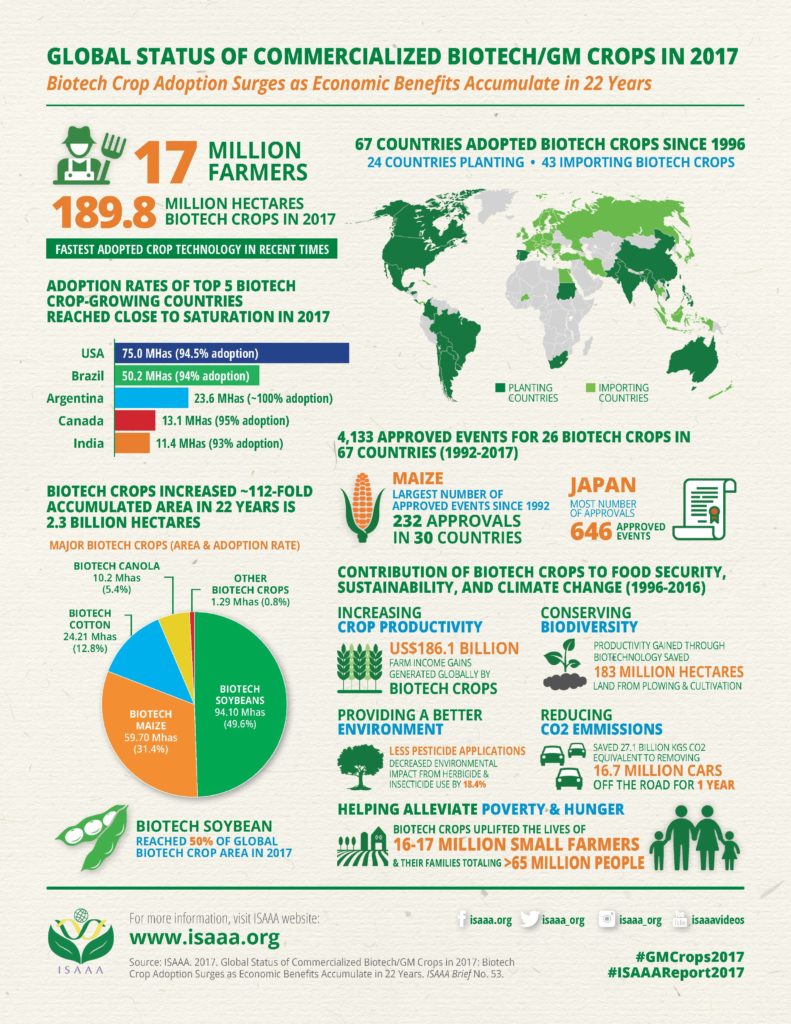Smallholder farmers in developing nations are fueling a steady expansion in the global cultivation of genetically modified (GM) crops, resulting in significant economic and environmental gains, according to new analyses.
The total world acreage planted in GM crops increased by 3 percent — 4.7 million hectares — last year, reaching a record 189.8 million hectares in 2017, according to studies by the International Service for the Acquisition of Agri-biotech Applications (ISAAA) and PG Economics, Ltd.
Some 19 developing nations — including India, Pakistan, Paraguay, Brazil, Bolivia, Sudan, Mexico, Colombia, Chile, Vietnam, Philippines, Honduras and Bangladesh — now account for 53 percent of the world’s acreage in GM crops.
Five industrial nations — led by the United States — also grow GM crops, and 43 countries, including 26 in the European Union, formally import biotech crops for food, feed and processing. In total, 67 of the world’s 195 countries have adopted biotech crops. It’s the fastest adopted crop technology in the world, achieving a 112-fold increase since its commercial introduction in 1996. Some 17 million farmers planted GM crops in 2017.
The widespread cultivation of biotech crops has brought about significant environmental and economic benefits, the studies found. In 2016 alone, GM crops resulted in reduced carbon emissions equal to taking 16.75 million cars off the roads. Biotech crops have also helped farmers cut their use of insecticides and herbicides, or apply the products more strategically, reducing the environmental impact associated with their use by 18.4 percent since 1996.
 Meanwhile, biotech crops generated $186.1 billion in economic gains to some 17 million farmers — many of them smallholder women solely responsible for the livelihood of their families — between 1996-2016. In 2016, the direct global farm income benefit from GM crops was $18.2 billion, equal to an average increase in income of $102/hectare.
Meanwhile, biotech crops generated $186.1 billion in economic gains to some 17 million farmers — many of them smallholder women solely responsible for the livelihood of their families — between 1996-2016. In 2016, the direct global farm income benefit from GM crops was $18.2 billion, equal to an average increase in income of $102/hectare.
Farmers are adopting the crops because they represent economic value. For each dollar invested in biotech crop seeds, farmers gained an average $3.49, the studies found. The return was highest for farmers in developing countries, who in 2016 received $5.06 for each dollar invested in biotech crop seeds, compared to $2.70 for farmers in developed nations.
“Biotech crops offer enormous benefits to the environment, health of humans and animals, and contributions to the improvement of socioeconomic conditions of farmers and the public,” said Paul S. Teng, ISAAA board chair in a press release. “The recent production of next generation biotech crops — including apples and potatoes that are not likely to spoil or become damaged, anthocyanin-enriched super sweet pineapple, increased ear biomass and high amylose content maize, and soybeans with modified oil content, combined with the commercialization approval for an insect resistant sugarcane — provides more diverse offerings to consumers and food producers.”
Biotech crops are increasingly offering nutritional quality traits that may help offset the nutrition-draining impact of climate change on certain crops, the studies found. Public sector institutions are conducting research on rice, banana, potato, wheat, chickpea, pigeon pea and mustard with enhanced nutritional benefits. This is important because studies show that climate change can considerably reduce the protein, zinc and iron content of staple crops, putting 1.4 billion children at risk of major iron deficiencies by 2050.
GM crops also increase yield. The technology has allowed farmers to grow more without needing to use additional land, reducing pressure on typically high biodiverse land to be converted for agricultural production. In the 21 years since their adoption, GM crops have produced 213 million tons of soybeans, 405 million tons of maize, 27.5 million tons of cotton lint and 11.6 million tons of canola.
The most widely grown GM crops are soybeans, maize, cotton. and canola. Smaller quantities of GM sugar beets, alfalfa, papaya, squash, potato, apples, pineapple and brinjal (eggplant) also are cultivated.
The two papers are published in the peer review journal GM Crops and Food here and here.
